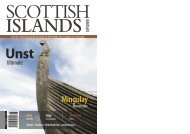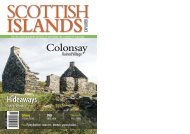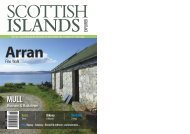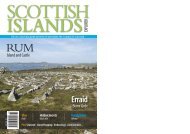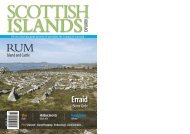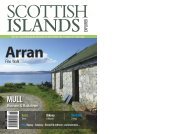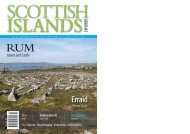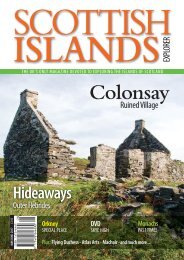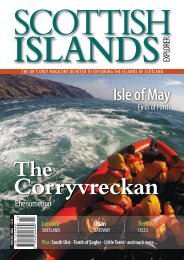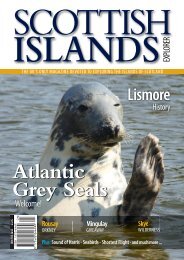You also want an ePaper? Increase the reach of your titles
YUMPU automatically turns print PDFs into web optimized ePapers that Google loves.
Machair<br />
Machair<br />
Unfortunately, the words of Bob Dylan -<br />
‘Times they are a-changing’ - applies to the<br />
machair as well as to many other areas of life.<br />
Machair<br />
Mavis Gulliver has witnessed a decline in abundance<br />
At its summer best the machair is a miracle. All<br />
winter long it endures the worst of Hebridean<br />
weather. It lies dormant through gales when salt-laden<br />
winds tear across the Atlantic Ocean. Every loose<br />
blade of grass is stripped and yet more sand is added<br />
to a substrate that has its origins in the sea.<br />
In wet winters, burns that run through the machair<br />
fill to overflowing. They gouge their way down to the<br />
bedrock and return sand to the sea in a headlong rush.<br />
At the landward end of the machair plain, the land<br />
becomes marshy or dotted with pools. It is then that<br />
birds flock in, winter visitors boosting the numbers of<br />
resident birds that feed on invertebrates.<br />
In addition to soil invertebrates, seaweed, thrown up<br />
by the sea, shelters small creatures that provide huge<br />
flocks with the sustenance they need. Ringed plover,<br />
oystercatcher, lapwing, redshank, turnstone, sanderling,<br />
purple sandpiper, whimbrel, golden plover, grey<br />
plover and bar-tailed godwit make the winter machair<br />
a paradise for birdwatching.<br />
Good Times<br />
Not limited to winter months, the machair is also<br />
renowned for the number of wading birds which visit<br />
each summer. They breed among dune slacks, on drier<br />
areas and on tussocks in wetter parts. In addition to<br />
waders, corn buntings, twite, skylark and corncrake<br />
make their nests. So spring and summer are equally<br />
good times for birdwatchers to visit.<br />
But what is machair? It is a Gaelic word for the flat<br />
land that lies above the shore. First adopted in the<br />
1940s by naturalists, it is now a recognised scientific<br />
term. The beaches and dunes of the Hebrides are<br />
partly composed of mollusc shells broken down by<br />
wave action. Wind deposits this shell-rich sand<br />
beyond the dunes. It is one of the rarest habitats in<br />
Europe and occurs mainly in the Outer Hebrides.<br />
There are entire books on the subject and it is only<br />
possible to skim the surface in this short article.<br />
‘Machair grassland’ is used for the flat sandy plain<br />
while ‘machair system’ refers to areas that include<br />
dunes and lochans. With a relatively low mineral<br />
content of silica sand, machair supports plants that<br />
are able to exist in alkaline conditions.<br />
Vital Resource<br />
Not only of importance to wildlife, machair is useful<br />
for the cultivation of crops such as oats and potatoes.<br />
In the past it was a vital resource for people who eked<br />
a living from land and sea. With shops now supplying<br />
all their needs, there is less incentive to keep up the old<br />
ways, although a few people still tend their plots by<br />
hand and feast on potatoes that taste much better than<br />
those from retail sources.<br />
28 SCOTTISH ISLANDS EXPLORER MAY / JUNE <strong>2017</strong><br />
MAY / JUNE <strong>2017</strong> SCOTTISH ISLANDS EXPLORER 29



